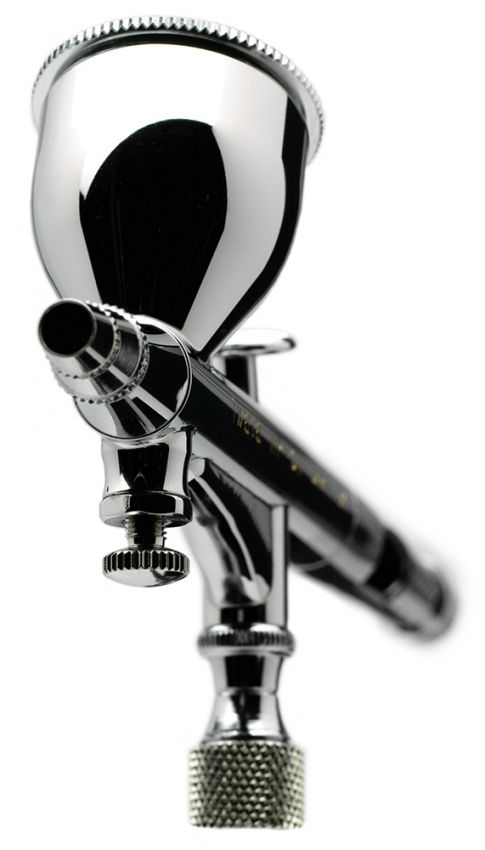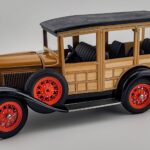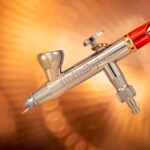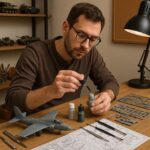Elevate Your Scale Models with Advanced Airflow and Thinned Paint Techniques
Mastering Camouflage with a MAC Valve
Creating realistic camouflage on scale modelling projects is both an art and a science. With the MAC Valve, modellers gain a precise tool to control the mixture of thinned paint and airflow, enabling them to mimic the diverse textures found in nature. By adjusting this device, you can transition from crisp, hard edges to delicate, soft transitions, elevating the realism of your models. This comprehensive guide covers the principles, equipment, step-by-step methods, and detailed comparisons between different MAC Valve configurations.
1. Understanding the MAC Valve
What Is a MAC Valve?
The MAC Valve is a specialised tool engineered for scale modellers. It works by precisely regulating the flow of thinned paint and the accompanying airflow, allowing for the controlled application of camouflage patterns.
How It Works: Airflow Regulation vs. Air Pressure
A critical concept in understanding the MAC Valve is that it regulates airflow, not air pressure. According to Bernoulli’s principle, as the velocity of a fluid increases, the pressure within that fluid decreases. The Venturi effect further describes how a fluid’s pressure is reduced when it flows through a constricted section of a pipe. In the MAC Valve system, these principles are harnessed to create variable spray patterns:
- Higher Airflow: Increased velocity through a constricted valve opening causes a rapid drop in pressure, producing a fine mist. This mist results in soft, diffused edges.
- Lower Airflow: Reduced velocity maintains higher pressure, resulting in a more concentrated stream of paint that produces hard, defined edges.
This precise control over airflow ensures that modellers can tailor their techniques to the desired effect without altering the overall pressure of the system.
2. Essential Materials and Setup
Equipment Checklist
- MAC Valve System: Ensure the valve is calibrated and functioning. Depending on your setup, the MAC Valve might be integrated into the airbrush or installed inline.
- Airbrush or Spray Gun: Use an airbrush compatible with your MAC Valve configuration.
- Thinned Paint: Prepare a palette of camouflage colours, thinned according to manufacturer recommendations.
- Air Supply: A regulated compressor or adjustable canister that delivers consistent pressure.
- Safety Gear: Respirator, gloves, and goggles to protect against fumes and overspray.
- Cleaning Supplies: Solvents, brushes, and cleaning mats to maintain optimal equipment performance.
Preparing the Paint
- Dilution: The paint must be thinned to a consistency that allows it to flow smoothly through the MAC Valve without clogging.
- Pre-Testing: Run a small amount of thinned paint through the valve before working on your final model to ensure the mixture behaves as expected.
3. Setting Up the MAC Valve for Camouflage Patterns
Calibrating the Valve
- Initial Check: Connect your airbrush or spray gun to the MAC Valve and test it with a neutral solution (such as water or a clear medium) to observe the baseline spray.
- Adjusting Paint Flow: Increase the paint flow to see how the system handles higher volumes. A larger paint volume will generally yield more defined edges.
- Regulating Airflow: Adjust the airflow setting to determine its effect. Higher airflow produces a softer, mist-like effect, while lower airflow delivers a concentrated, hard-edged spray.
Fine-Tuning for Pattern Variations
- Hard Edge Application: Use a lower airflow and a slightly higher volume of thinned paint. This setting produces a concentrated stream ideal for crisp boundaries.
- Soft Edge Application: Increase the airflow relative to the paint volume to achieve a delicate, feathered transition that mimics natural blending.
4. Configurations: Built-in MAC Valve vs. Inline MAC Valve
Built-in MAC Valve Airbrush
Some airbrushes come with an integrated MAC Valve system. This design offers several benefits:
- Streamlined Design: With the MAC Valve built directly into the airbrush, the system is compact and often easier to handle.
- Enhanced Responsiveness: Integrated systems can offer faster adjustments because the valve mechanism is closely linked with the airbrush controls.
- Consistent Performance: A built-in MAC Valve may provide more uniform results since it is designed as a single, cohesive unit.
Inline MAC Valve Fastened at the Airbrush Air Stem
An alternative configuration is an inline MAC Valve that is fastened to the airbrush’s air stem. Here are some key points:
- Modular Flexibility: Inline systems can be swapped or upgraded independently from the airbrush, offering greater flexibility for advanced modellers.
- Customisation: With an inline valve, you can tailor your setup more precisely by combining different airbrush models with specific valve systems.
- Installation Considerations: Although mounting an inline MAC Valve may require additional setup steps, it provides a robust solution for those who want detailed control over airflow dynamics.
Which Configuration Is Right for You?
The decision between a built-in and an inline MAC Valve depends on your modelling needs:
- Built-in MAC Valve: Ideal for those seeking simplicity and rapid, consistent results.
- Inline MAC Valve: Suited for advanced users who require customisation and are willing to invest extra time into fine-tuning their equipment.
5. Step-by-Step Camouflage Application
Step 1: Designing Your Pattern
- Planning: Begin by sketching your camouflage layout on paper or lightly on your model. Identify areas that require sharp lines versus blended transitions.
- Sectioning: Use masking tape or stencils to segregate sections, ensuring clean separations between different colours or edge styles.
Step 2: Configuring the MAC Valve
- Select Settings: Adjust your MAC Valve to the desired paint-to-airflow ratio. For hard edges, use a lower airflow; for soft edges, increase the airflow.
- Test Spray: Always test your settings on a spare surface to verify that the spray pattern meets your expectations.
Step 3: Application Process
- Base Coat: Start with a base coat of the primary camouflage colour and allow it to dry completely.
- Layering: Apply additional layers according to your design:
- Hard Edges: Hold the airbrush close to the surface with the valve set for a concentrated spray.
- Soft Edges: Increase the distance between the airbrush and model while adjusting for higher airflow to create a diffused effect.
- Overlap Techniques: Slightly overlap adjacent spray areas to blend hard and soft edges naturally.
Step 4: Detailing and Refinement
- Touch-Ups: After the main layers have dried, use the MAC Valve on a finer setting to add subtle details or correct transitions.
- Curing: Ensure that each layer dries completely to avoid unwanted mixing of colours and effects.
6. Tips, Best Practices, and Troubleshooting
Best Practices
- Experimentation: Each model and paint type may respond differently. Record your settings and techniques in a dedicated notebook for future reference.
- Regular Maintenance: Clean your MAC Valve and airbrush after each session using recommended solvents and brushes to prevent clogs and maintain accuracy.
- Controlled Environment: Work in a stable environment with consistent temperature and humidity to ensure reliable performance of your thinned paint and airflow.
Troubleshooting Common Issues
- Inconsistent Spray Patterns:
- Potential Causes: Variability in paint viscosity or inconsistent air supply.
- Remedy: Verify your paint mixture and check that your compressor is delivering steady pressure.
- Over-Blending of Edges:
- Potential Causes: Airflow set too high for a given effect.
- Remedy: Reduce the airflow setting on the MAC Valve to achieve more defined boundaries.
- Clogged Valve:
- Potential Causes: Dried paint residue in the valve.
- Remedy: Clean the valve promptly after each use using the appropriate cleaning agents and brushes.
7. Scientific Underpinnings: Bernoulli’s Principle and the Venturi Effect
The precise regulation provided by the MAC Valve is grounded in fundamental principles of fluid dynamics:
- Bernoulli’s Principle: This principle explains that an increase in the velocity of a fluid results in a decrease in its pressure. In the context of the MAC Valve, when paint and air are forced through a narrow opening, the increase in speed causes a drop in pressure, leading to a finely atomised spray.
- Venturi Effect: Closely related to Bernoulli’s Principle, the Venturi effect describes how fluid passing through a constricted channel experiences reduced pressure. This effect is harnessed by the MAC Valve to adjust the dispersion of thinned paint. By fine-tuning the valve settings, modellers control the airflow to achieve either a concentrated stream for hard edges or a mist-like spray for soft edges.
Understanding these principles helps clarify that the MAC Valve is designed to regulate airflow—not the overall air pressure in your system. This distinction is crucial because the aim is to manipulate how paint is dispersed over the model, ensuring that the final camouflage pattern appears both natural and convincing.
8. Bonus: Why Practice is Important for Airbrush MAC Valve Proficiency
Proficiency in using a MAC Valve does not come overnight; it requires regular practice and experimentation. Here’s why honing your skills is vital:
- Skill Refinement: Repeated practice allows you to develop a steadier hand and better control over the valve adjustments. Each session builds muscle memory, which is essential when you need to replicate precise spray patterns under different conditions.
- Understanding Variations: Every paint type and environmental condition can affect the way thinned paint flows and atomises. Regular practice helps you understand these variations, enabling you to adapt your settings on the fly.
- Problem Solving: With more practice, you become better at identifying and troubleshooting common issues such as inconsistent spray patterns or over-blending of edges. This experience is invaluable for maintaining a smooth workflow during detailed projects.
- Experimentation and Creativity: Practice sessions offer a safe space to experiment with different techniques and configurations. This experimentation not only leads to improved technical skills but can also spark creative ideas, pushing the boundaries of what you can achieve with camouflage effects.
- Confidence Building: Mastery of your equipment builds confidence, ensuring that when you work on your final models, you can focus on creativity without worrying about technical setbacks.
Investing time in practice transforms the use of a MAC Valve from a mere technical process into a well-honed art form that enhances the overall quality and realism of your scale modelling projects.
Conclusion
Utilising a MAC Valve in your scale modelling projects opens up a realm of creative possibilities, allowing you to tailor camouflage patterns with pinpoint accuracy. Whether you’re using an airbrush with an integrated MAC Valve or an inline version mounted at the air stem, understanding and manipulating airflow is key to achieving the desired effect. By leveraging principles such as Bernoulli’s and the Venturi effect, you gain full control over the spray characteristics, ensuring that each layer of camouflage—whether marked by hard, defined lines or soft, blended transitions—brings your model to life.
Happy modelling, and may your efforts in achieving the perfect camouflage always be guided by precision, experimentation, and a deep appreciation for the art and science behind it!






